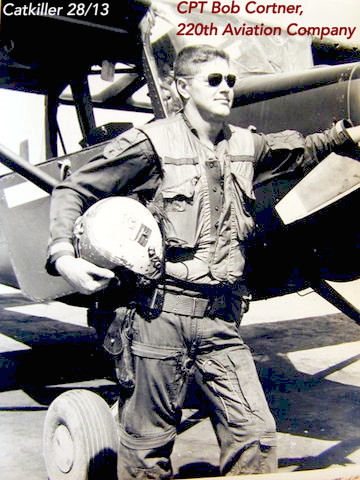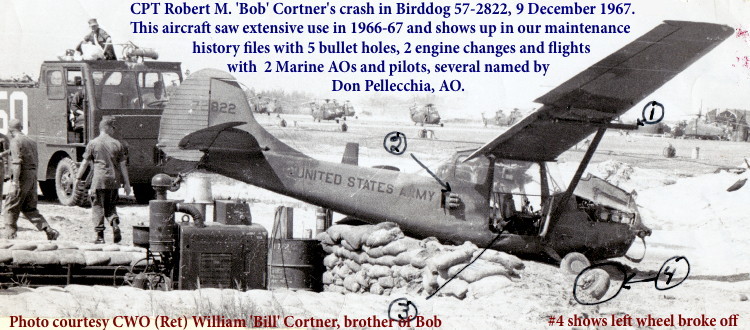CAPTAIN CRASH:
MY ABNORMAL FIRST COMBAT MISSION
By Captain Robert M. ‘Bob’ Cortner, Catkiller 13/28. 1967–68



with research assistance from his brother, William ‘Bill’ Cortner, CWO, USA, Retired (1953-1980)
I stayed at Phu Bai for about two weeks where I received my in–country orientation and proved that I could fly the airplane. We would take off and fly in the area I would be working and made landings at the little airfield in Hue City. It was a cute little thing, less than 2000 feet and narrow. I had no problems with my landing as I was an Aviator Extraordinaire.
We flew all the way to the DMZ and points inland that I would be flying with the second platoon. This is where I was first introduce to the “Street Without Joy.” A long narrow piece of land filled with bomb craters and rice paddies. I was told that this was what is called a “Free Fire Zone.” That is, if any one was spotted in the street he was to be classified as the enemy and we could go after him any time we saw fit. If you looked hard enough you could almost every time find people in the street. Actually, there was no street to be found. It was an area about 1 to 1 ½ miles wide and about 30–40 miles long. It was said that there were to large groups of bad guys in the street at all times. One group were the fighters and the other group were the farmers. Since both groups were bad guys, we tried to take them out every chance we got.
After my checkout I then moved north to Hue where I would live and start out each day of combat flying. If we were supporting the ARVN unit we would pick up our observer at Hue, but if we were supporting the Marines we would fly down to Phu Bai and pick up the observer. I was ready to go and full of spunk and bravado.
However, my first combat mission would prove that maybe I needed work on my landings, well, maybe. That is, if they were going to let me take off again. Every takeoff needs a landing to successfully complete the flight. My first landing proved that not all flights are successful, even if you don’t get shot down or crash somewhere. Well, I made most of the landing okay—just the rollout left something to be desired.
Having no idea what to do next I wrote out what I thought happened, when really I had no idea, and waited for their next move. The next day a couple of pilots showed up from group headquarters in Da Nang to investigate the accident. They said it would be a fair and complete investigation but it looked like pilot error and just another ground loop, which is common with the O–1 aircraft. Before they moved the plane from the crash site I took photos and sent them to my brother in Korea to be developed. They showed where I was dragging the left wheel sideways which would indicate the strut had failed thus not a common ground loop. However, after professionally investigating the accident over a couple of days and a couple of beers it was decided that it was the classic ground loop. I didn’t have the photos at that time to prove anything different so I just went back up with an instructor and demonstrated that I was safe to fly again so back in the war I went.
A couple days after I was classified safe again I went to preflight the bird and one of the crew chief’s came up and called me “Lieutenant Crash.” This stuck like glue on me with him and after I made Captain he changed my nickname to “Captain Crash.” It was our own little joke and thank God none of the other crew chiefs picked up on it.
Bob

Gene Wilson, Catkiller Historian: According to Bobby Jack Woolley on page 166 of his book, The Bird Dogs’ Tale, Army 57–2822, a 220th Catkiller O–1D, crashed during landing go–around on 12/9/67. Location not noted. It entered service in the 220th in May 1966. [Editor: Bob Cortner’s brother, Bill, sent the statement below, so this reported event by Mr. Woolley places it in time sequence for this event. In our history and maintenance records are these findings following Bill’s statement:
- Bob tour in Vietnam was from 23 November 1967—22 November 1968. That would make dates jive. Seems like I remember a John T. Mulvany, Catkiller 16, 1967—68, being mentioned as giving him his in-country check ride. Bill Cortner, CWO, USA Retired.
- The last flight recorded in our maintenance history file was with CPT Bil Faulkner and Don Pellecchia on 28 November 1967. This aircraft saw a lot of combat and has five bullet holes recorded during 1967, numerous flights with Don Pellecchia and one with Jack Schaeffer. Don Pellecchia’s recorded flights with Dennis O’Connor (March), Ray Arrington (April), Ernie Serna (April), Dick Tobiason (April-twice), Mike Sharkey (October-three times), Harold Vail (October), and Bill Faulkner (Novenber 28). That was the last this aircraft number is used in that particular log. Jack Schaeffer did not enter his pilotís name but his only flight in the aircraft was 21 May 1967. Don Ricks, Editor
Comments:
I sure hope that Bill Cortner has the data on Bob’s engine failure and dead stick (successful this time) landing on the beach. He definitely redeemed himself on that one. I flew over the site the next day and all that was left was the engine block—the bad guys had burned it in place before we could retrieve it.
Ray Caryl, Catkiller 32/42
Regarding the second unplanned landing, or the successful one, I will try to recall from our conversations:
Bob was returning from a mission at night—flying along the coast—when his aircreft started to have engine trouble. He had flown this route many times and had always thought that the beach would make a good emergency landing area. He went on to say that the situation with the engine did not improve and he decided to declare an emergency. He then set up to land on the beach when the back seat (Vietnamese) told him not to land that there were many VC in the area. In response to his emergeny a Marine Ch–46 said he would pick them up. Story goes that they landed, got out ran to the CH–46, it lifted off and almost immediately his plane was on fire. This must be the dead stick that Ray Caryl wrote about.
I have read a lot of things that Bob has written but somehow this one got lost in the shuffel. No one can tell a story like Bob. Gonna miss Lil Bro.
It a great honor to know that my brother Bob Cortner was a warrior brother to such a great group of men.
May god bless and keep each of you in his folds.
William Cortner, CWO, USA (Ret.) [older brother of Bob]
EDITOR’S NOTE: Everybody probably remembers their first few days in Vietnam—enlisted or officer. They also might recall how disoriented and uncertain life in their unit seemed, initially. Checkouts of any sort usually came around quickly, for every job was important and needed. Now, for pilots, that first flight with an instructor or standardization pilot, especially that initial orientation flight, was first to observe and then sooner than later to have a chance to show their stuff. Pilots were eager to demonstrate they were well–trained and were attentive in training sessions and had brought to Vietnam the latest army doctrine could teach. They wanted to prover their skills, do well, and not get ourselves or anybody else killed. Was there pressure caused by pride, a keen desire to do well, and to fit in? Yep, there was.
Pilots usually did well, but most having been off active flying status for a while, engaged in other training and/or annual leave, and thus were out of the cockpit for one to two months. This added to the apprehension, of course, but when asked for his opinion of effectiveness of the two dozen or so men he checked out while in Vietnam, Jack Bentley said, “I was generally impressed with the expertise, professionalism and enthusiasm of those just out of flight school, especially considering most hadn't flown for a while.” The training we had at Fort Rucker was thorough, challenging, and confidence–building. Just recall the short field landings over a barrier sessions we had!! Anyone could have an accident, and if a pilot thought in a complacent manner his chances were often stacked high in favor of him having one. Sometimes, no matter what decision we made—in that split second when we usually had only one choice—very quickly the worst happened (most often classified as pilot error).
CPT Bob Cortner was later awarded the Distinguished Flying Cross for his heroic actions on 8 August 1968 and would return to the United States on 22 November 1968.
Robert M. Cortner died 2 April 2014 in California while convelescing at his daughter’s home but had been place in Hospice care following confirmation from tests that he had a life–threatening condition.





